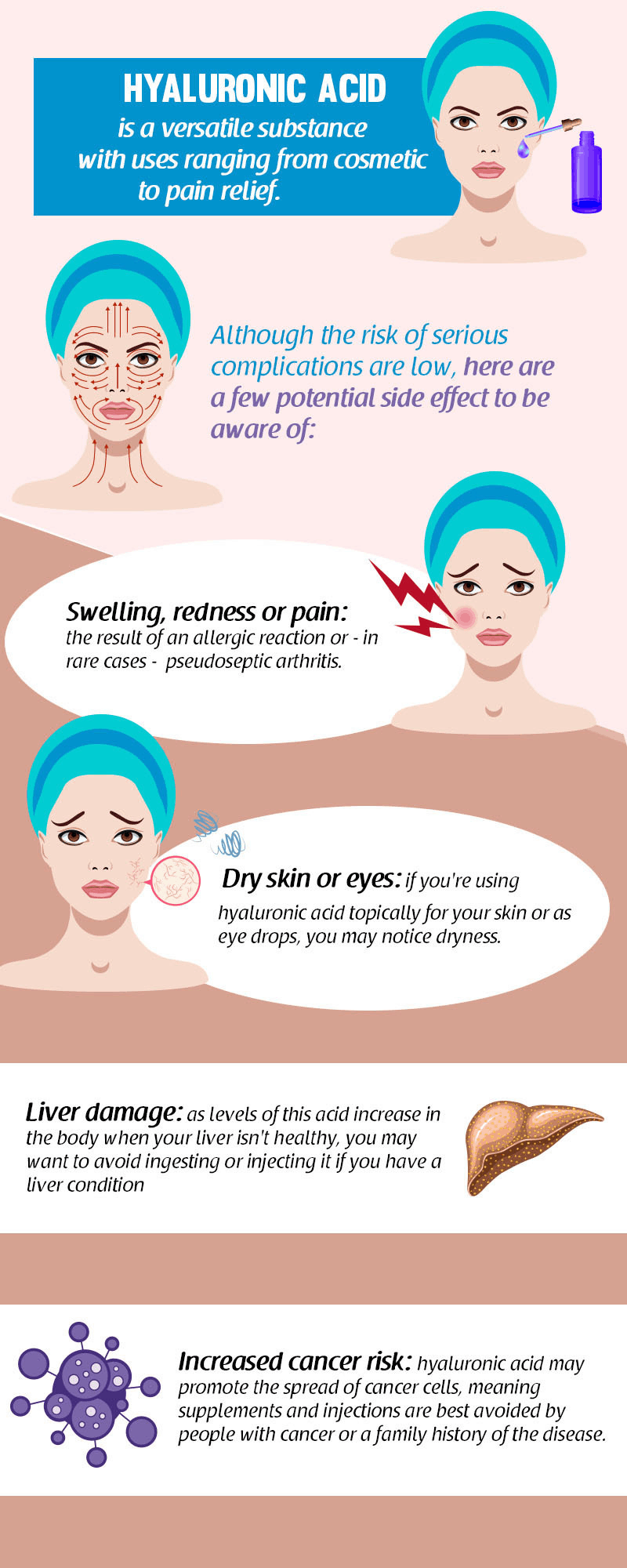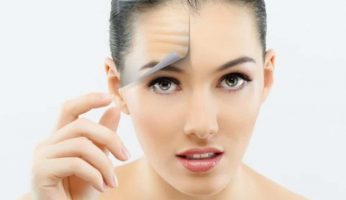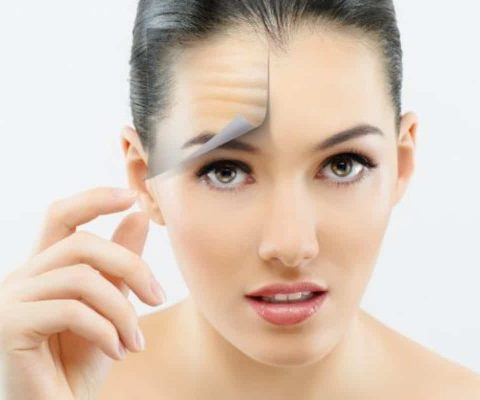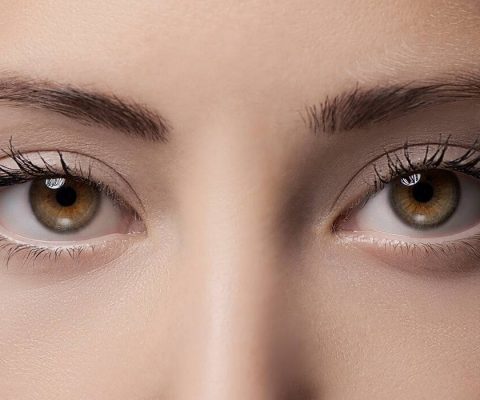Complete Overview of Hyaluronic Acid Side Effects
Disclosure: We use affiliate links and may receive a small commission on purchases.
 Complete Overview of Hyaluronic Acid Side Effects
thefitbay.com
Complete Overview of Hyaluronic Acid Side Effects
thefitbay.com
Hyaluronic acid is a naturally occurring substance in the body that’s important for health, but such substances can come with side effects, even if you use the best hyaluronic acid supplements.
We wouldn’t say there’s anything major to fear, though. Hyaluronic acid is such a powerful component for many bodily functions, that we can’t get enough of it.
If you want to cut to the chase, here are some things to know, although hyaluronic acid is effective and very safe to use. There are no extreme side effects of using the substance, but possible side effects include:
- Pain.
- Pseudoseptic reaction.
- Swelling.
- Itching.
- Bleeding.
- Increased eye pressure.
- Allergic reactions.
What Are the Side Effects of Hyaluronic Acid?

No product is without its side effects, but there’s nothing to be alarmed about — hyaluronic acid is safe and FDA-labeled and approved for several of its uses. (1) Just be aware for the sake of your health.
If you experience any negative effects using medicines containing hyaluronic acid, contact a healthcare professional.
First, we’ll examine the hyaluronic acid injections side effects. These injections aren’t solely used as a treatment for joint pain. Hyaluronic acid fillers are common in cosmetic treatments, too.
Increased Knee Pain
Though used to relieve these symptoms of joint pain, an increase in knee pain may occur. This might be because hyaluronic acid injections directly to the knee can irritate at the injection site.
Look after your injection site properly. Keep it clean, and try to avoid rubbing rough materials against it. Although tiny, it’s easy for your injection site to come in contact with bacteria. This bacteria is much of what causes infection.
If symptoms persist, you may need to discontinue this pain relief treatment to better your overall health. Alongside having the injections, you should also practice stretching as recommended by a health professional.
Pseudoseptic Reaction
Viscosupplementation is the procedure where injections are used to treat knee osteoarthritis. This will typically be a hyaluronic acid injection.
Though rare, a pseudoseptic reaction may occur with viscosupplementation. (2) Swelling, redness and pain are the common side effects associated with this reaction.
Allergic Reaction
Hyaluronic acid is a substance your body creatures naturally, so it’s very rare for it to cause any allergic reactions. Allergic reactions to this treatment have symptoms that include:
- Itching.
- Rash/redness.
- Warming of the skin.
If you think you have an allergic reaction, contact your doctor immediately. It may just be irritation around the injection site, but it’s still best to visit your doctor to rule out an infection.
Patients with a history of anaphylaxis need to be cautious when using hyaluronic acid (3).
Hyaluronic Acid Supplements Side Effects

Outside of the joints, hyaluronic acid is used for many things, such as a daily supplement for your overall health and wellbeing. It’s not just good for your bones and joints, but the rest of your body, too.
You should always check with your doctor before you try a new supplement. Your doctor will know if it’s okay to take with any pre-existing health conditions you have. Your doctor will also know if it’s safe to take with any medications you might be on.
There are few side effects reported with hyaluronic acid supplements. Its ingredients are natural, and oral hyaluronic acid may be even safer than injections — there’s no injection site to get infected or inflamed.
The hyaluronic acid supplement side effects are primarily limited to allergic reactions. Again, these are uncommon.
A year-long study on oral hyaluronic acid supplements shows no ill effects. (4)
Recap
In the unlikely event that you experience negative effects using hyaluronic acid, talk to your doctor. It’s a safe, natural substance that your body shouldn’t have problems with. Your biggest possible issue with hyaluronic acid will be your injection site. The most common side effects are pain, a pseudoseptic reaction and an allergic reaction.

Hyaluronic Acid for Skin Side Effects
Hyaluronic acid soothes the skin, helps with wound healing and plays a role in keeping the skin healthy and supple. (5)
When it comes to hyaluronic acid serum side effects, there are generally few to none. The same can be said for cream and all topical treatments. Look out for anything unusual, but this treatment usually does more good than bad for your health, and rarely do reactions occur.
Hyaluronic acid is safe for use on the skin. Always read the instructions provided with your cream or serum. If used incorrectly, it may end up drying out your skin.
This is possible since hyaluronic acid pulls moisture from the air, so if used in excess on dry skin or in low-moisture air, it can’t function properly. When there’s no moisture to pull out of the air, it pulls it from your skin — the very thing it’s trying to keep hydrated.
Proper Use of Hyaluronic Acid for Skin
The founder of skincare brand Pestle and Mortar, Sonia Deasy, has input on this subject. She recommends layering hyaluronic acid serums with a moisturizer. (6)
She explains that the moisturizer helps seal the hyaluronic acid serum into your skin. This creates a barrier so you don’t lose moisture from the serum.
Deasy has also advised applying serum on damp skin. This gives better results than applying it directly onto dry skin.
If you follow these practices, you should be able to avoid drying out your skin.
Hyaluronic Acid for Cosmetic Procedures
Due to its existence already in the body, hyaluronic acid is used in some dermal fillers. Dermal fillers are used as a treatment for fine lines and skin wrinkles, and in the lips.
With the injections comes an injection site, like when used around the joints. Itching, burning and redness can occur after treatment. This usually subsides within a few days.
Hyaluronic acid in dermal fillers isn’t permanent, though—the body breaks this down over time. You’ll, therefore, need treatment again, in as little as 3–9 months.
All fillers can give your skin an uneven, bumpy appearance. This isn’t unique to hyaluronic acid, but take precautions. Make sure your doctor knows what they’re doing to help avoid a negative outcome.
Hyaluronic Acid for Dry Eye Side Effects
Dry eye is caused by decreased tear production. (7) Your tears help make the surface of your eye smooth, so a lack of them is far from ideal.
Hyaluronic acid is used in eye drops frequently. It’s a moisturizing substance but may cause you concern when you think about it more deeply. Hyaluronic is present in our joints, so are we sure they’re compatible with your eyes?
Never fear. Surprisingly, there are actually little to no recorded side effects of using specifically hyaluronic acid eye drops.
Some side effects associated with general lubricant eye drops — which may or may not contain hyaluronic acid — are:
- Temporary blurred vision.
- Minor burning/stinging.
- Eye pain.
- Continued eye redness or irritation.
Hyaluronic Acid Eye Injections
Other than dry eye, hyaluronic acid is used during eye surgery. It’s injected to replace natural fluids during eye procedures such as:
- Cataract removal.
- Corneal transplants.
- Detached retina repairs
It’s FDA-approved and just as safe as the eye drops.
Hyaluronic acid can increase eye pressure if injected into the eye, but this usually resolves itself within a few days. (8) Luckily, the person injecting it will be trained in all things eye-related. Stay on top of your eye check-ups and talk to your doctor if your eyes feel different than usual.
Hyaluronic Acid for Bladder Pain

The bladder is protected by a barrier layer of glycosaminoglycan — GAG. The loss of this layer lowers the resistance of the bladder wall, leading to pain.
Interstitial cystitis, also known as bladder pain syndrome — BPS — can be treated with hyaluronic acid through intravesical therapies.
However, there is a negative to this. A study shows that after 24 weeks, there’s a moderate decrease in the effectiveness of the treatment (9). The main side effect of this intravesical treatment is irritation, or a burning feeling in the bladder (10).
Recap
Hyaluronic acid is a versatile substance. It can bring you joy by getting rid of pain. The overall consensus so far is that it’s safe in all forms. Any ill-effects you experience most likely won’t be substance-specific.
Hyaluronic Acid Side Effects — Liver
Many tend to worry about how hyaluronic acid will influence their liver. There’s no evidence to suggest that hyaluronic acid will harm the liver, but levels of hyaluronic acid in the body increase with liver damage. (11) These increased levels of hyaluronic acid are taken as an indicator of:
- Hepatitis C.
- Severe fibrosis.
- Fatty liver.
- Liver cirrhosis.
- Inflammation.
For this reason, using oral hyaluronic acid — hyaluronic acid supplements — isn’t advised if you already have a liver condition. On that note, let’s discuss who shouldn’t be using hyaluronic acid.
Who Should Avoid Using Hyaluronic Acid?
Pregnant and breastfeeding women should avoid using hyaluronic acid.
There isn’t enough scientific evidence proving whether hyaluronic acid is safe or unsafe in these instances, so it’s best avoided until experts deem it to be safe. It’s undetermined whether or not it affects breast milk or unborn infants.
You should take precautions taking any supplements when pregnant or breastfeeding, let alone hyaluronic acid supplements.
As mentioned above, those with liver conditions should also avoid taking hyaluronic acid. People with a history of cancer should do the same.
Does Hyaluronic Acid Increase Your Risk of Cancer?
There’s some evidence to suggest hyaluronic acid promotes the spread of cancer cells (7) and that taking hyaluronic acid can make tumors grow faster. (12)
Levels of hyaluronic acid in the body are also used to monitor how the disease is progressing. They can be a tumor-indicator for breast and prostate cancer. (13)
People with a history of cancer, or a family history of the disease, should avoid taking even the best hyaluronic acid supplements. (14)
Can Hyaluronic Acid Cause Acne?

Hyaluronic acid is often used in acne treatments because of its positive impact on skin health. However, there’s no evidence to suggest it prevents acne.
It’s easy to assume, based on its wound-healing abilities, that hyaluronic acid can help clear up existing acne. There’s no evidence for this either, though.
However, studies suggest hyaluronic acid may help clear up acne scars. (15)
Because hyaluronic acid is moist and oily skin is acne-prone, you may wonder if it causes acne while not directly healing it. It won’t, though — hyaluronic acid doesn’t clog pores or cause breakouts.
Hyaluronic acid may speed the healing of the acne skin wounds, but it won’t solve the underlying acne cause or heal acne pimples that have yet become open or wounds.
Interactions With Other Skin Care Products
Hyaluronic acid is predominantly fine to use with most products.
There’s one thing to look out for — low-pH acids. Low-pH acids, like glycolic acid, may reduce the effectiveness of hyaluronic acid. (16)
Glycolic Acid
Glycolic acid functions similarly to hyaluronic acid when it comes to skin — it has anti-aging properties and is great for exfoliation.
Glycolic acid moisturizes the skin, inside and out, and helps you shed dead skin cells. Although hyaluronic acid doesn’t help treat acne, glycolic acid can.
It’s not set in stone that hyaluronic and glycolic won’t work together. It’s all a game of maybe, maybe not. If you wish to incorporate both into your skincare routine, it won’t have any negative outcomes.
Experiment and see what works best for you. You can always discontinue the use of glycolic acid if it stunts the effectiveness of hyaluronic acid.
What’s the Riskiest Form of Hyaluronic Acid?
The riskiest form of hyaluronic acid would have to be when it’s used in lip fillers.
Lip fillers can be used cosmetically for personal, beauty-related reasons or to reduce the signs of aging. As you age, your lips naturally lose their volume.
The reason this is the riskiest form is because of how much can go wrong. If injected incorrectly, such as accidentally blocking a blood vessel, they can cause vascular occlusion (17). During vascular occlusion, the blood vessel is usually blocked by a clot. If an injected substance blocks the blood flow, this can cause that clot to form.
Of course, this can occur anywhere, not just in the lips. The lips seem to be the riskiest because of the tissue loss that can occur. (18)
The lips are one of the most obvious places you can lose tissue. (19) They’re naturally protruding and plump, so if uneven, it’s immediately noticeable.
Avoiding Faulty Dermal Fillers
Always do deep research into the clinic and person offering dermal fillers. Make sure they’re medically licensed.
Doctors and nurses can become certified in the application of dermal fillers. Try going to one of those, rather than a beautician first, and remember that getting any sub-optimal treatment is a health risk.
The Bottom Line
Many of the potential side effects come from the procedures done, not the substance used. Pain, irritation, swelling and redness mainly come from injection sites and intravesical procedures. The same side effects come with allergic reactions, which are rare but not impossible. Always be cautious when using hyaluronic acid.
Despite these side effects, hyaluronic acid is a very low-risk product to use. Its effectiveness and benefits outweigh most risks, and it plays a big part in your health. Whether you’re using it for your skin or your joints, always be cautious. Although the product is risk-free for most, you can never be too careful.










